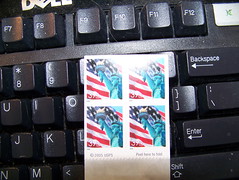Originally uploaded by freerangelibrarian.
(a work in progress, as this post got posted live and now I’m writing it in pieces throughout this evening, saving as I go along.)
Today, while a breeze stirred the preternaturally dry spring air, I sent out six essays.
I don’t buy lottery tickets; I lose interest in slot machines after the first two-dollar loss; poker bores me, and sports bets confuse me. But submitting my work to literary quarterlies has taught me why people gamble.
The joy of the bet is that delicious, sub-erotic slice of time between commitment and resolution.
First is the dance of engagement where I compose a submission letter and hand-address a manila envelope. (By this time I know my quarry; I have spent evenings, even weeks, convincing myself that a certain journal is just the right match for a certain essay.) Then, while I print off the essay, I address a second envelope for the journal’s reply–the well-known, even mystical SASE (for Self-Addressed Stamped Envelope).
Increasingly I simply enclose a letter-sized SASE, rather than one large enough for the manuscript to be returned. It sounds eco-thrifty to have the manuscript returned, and I did that in my literary youth (that is, last year); but by the time the manuscript comes back I inevitably have found more revisions to make, more words to spin on a dime, more ways to make its luck happen.
The large manila envelope I use for sending the essay gets four first-class stamps. I don’t know if that’s extravagant; it’s not too little, because they always find their way to the journal, but that may be too much. But that’s not the betting part of this game.
It is the stamp I place on the reply envelope that clenches all of my hopes in its tiny paper heart. This stamp will carry an answer to my mailbox and tell me if my luck holds. Maybe an essay will get accepted; maybe it will get rejected with a kind note; maybe I will get a form rejection (unfailingly accompanied by a letter urging me to subscribe to the journal in question, which really hurts when I have already subscribed, like the pang of meeting an old colleague who doesn’t recognize me).
I have had acceptance and rejection, and I know which feels better; but nothing feels quite so feather-light–not even the joy of acceptance–as that vast sky of possibility arching over the time between the moment when into the corner mailbox I slide my essay’s sealed manila envelope, knowing a small stamped envelope throbs within, and the moment when in thumbing through the mail I see an envelope whose hand I recognize, because it is mine.
Hope is a first-class stamp, over and over again. A small cost for what it gives me.











I took all my manuscripts to the post office to mail, partly because I like going to the post office and partly because I am cheap and don’t wish to spend more than is necessary to mail something–and I saved all the receipts on the theory that all that small change was tax deductible for a (quasi) working writer. But yes–you’ve captured exactly the feeling I used to get when I slid a mss. into a manila envelope.
At the magazine I work for, we have a point in the process we call the good-to-go version, the point at which it goes to the top editor. Theoretically, this version is something I, as a staff editor, thinks could go in the magazine as-is (which is of course totally unrealistic).
The feeling is much the same: “This piece is really good, maybe he’ll love it. He should love it, dammit! It’s really good. I hope he loves it.”
At the risk of invoking The Gospel According to ‘A Chorus Line,’ we can all connect to that song, “I hope I get it.” It’s that buoyant space in between submission and resolution that keeps us going.